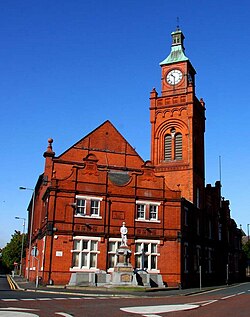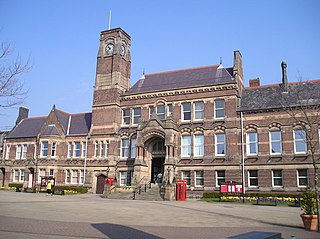
Earlestown is a town in the Metropolitan Borough of St Helens in Merseyside, England. At the 2011 Census the town had a population of 10,830.

Newton-le-Willows is a market town in the Metropolitan Borough of St Helens, Merseyside, England. The population at the 2011 census was 22,114. Newton-le-Willows is on the eastern edge of St Helens, south of Wigan and north of Warrington.

Earlestown railway station is a railway station in Earlestown, Merseyside, England, and one of the few "triangular" stations in Britain.

Haydock is a village within the Metropolitan Borough of St Helens, in Merseyside, England. At the 2011 Census, it had a population of 11,416 Haydock's historic area covers the Haydock electoral ward and a section of the Blackbrook ward.

Whiston is a town and civil parish within the Metropolitan Borough of Knowsley in Merseyside, England. Previously recorded within the historic county of Lancashire, it is located eight miles east of Liverpool. The population was 13,629 at the 2001 Census, increasing to 14,263 at the 2011 Census.

St Helens is a large town in Merseyside, England. It is the administrative centre of the wider Metropolitan Borough of St Helens which covers a larger area around the town.

St. Helens North is a constituency created in 1983 represented in the House of Commons of the UK Parliament since 2015 by the Labour Party's Conor McGinn, Shadow Minister without Portfolio from 4 December 2021. Between 1997 and 2015 the MP was Labour's David Watts.

St Helens Junction railway station is a railway station serving St Helens, Merseyside, England. It is in Sutton, three miles southeast of St Helens town centre. The station is on the electrified northern route of the Liverpool to Manchester Line, 12 miles (19 km) east of Liverpool Lime Street. The station and all trains calling there are presently operated by Northern Trains.

Eccleston is a civil parish in the Metropolitan Borough of St Helens, Merseyside, England. At the 2011 census, it had a population of 10,433.

Newton-le-Willows railway station is a railway station in the town of Newton-le-Willows, in the Metropolitan Borough of St Helens, and at the edge of the Merseytravel region. The station is branded Merseyrail. The station is situated on the northern route of the Liverpool to Manchester Line, the former Liverpool and Manchester Railway which opened in 1830. It is a busy feeder station for nearby towns which no longer have railway stations, such as Golborne, Billinge and Haydock. There is also a complimentary bus shuttle service to Haydock Park Racecourse on certain racedays.

Lowton is a village within the Metropolitan Borough of Wigan, in Greater Manchester, England. It is around 2 miles (3 km) from Leigh, 7 miles (11 km) south of Wigan and 12 miles (19 km) west of Manchester city centre. The settlement lies across the A580 East Lancashire Road.

St Helens is a large town and the administrative seat of the Metropolitan Borough of St Helens in Merseyside, England. The town was incorporated as a municipal borough in 1868, responsible for the administration of the four townships and manors of Eccleston, Parr, Sutton and Windle. In 1887 this role was expanded to a county borough, which was superseded in 1974 by the larger metropolitan borough.

St John the Baptist's Church is in Market Street, Earlestown, St Helens, Merseyside, England. It is an active Anglican parish church in the deanery of Winwick, the archdeaconry of Warrington, and the diocese of Liverpool. Its benefice is united with those of St Peter, Newton-in-Makerfield, All Saints, Newton-le-Willows, and Emmanuel Wargrave, Newton-le-Willows. Revd Dr Chris Stafford is currently the Team Rector for the Benefice.

St Helens Council, also known as St Helens Borough Council and St Helens Metropolitan Borough Council, is the local authority of the Metropolitan Borough of St Helens in Merseyside, England. It is a metropolitan district council, one of five in Merseyside and one of 36 in the metropolitan counties of England, and provides the majority of local government services in St Helens. It is a constituent council of Liverpool City Region Combined Authority.
St Helens is a town in the Metropolitan Borough of St Helens, Merseyside, England. The unparished area contains 67 buildings that are recorded in the National Heritage List for England as designated listed buildings. Of these, one is listed at Grade I, the highest grade, five are listed at Grade II*, the middle of the three grades, and the others are at Grade II, the lowest grade. The main town in the district is St Helens, the others being Newton-le-Willows and Earlestown. Until the Industrial Revolution, the area was largely rural. Coal mining began in the 16th century, but modern industrial development began with the construction of the Sankey Canal in the late 18th century, linking St Helens with the River Mersey. The early 19th century saw new industries, including copper smelting, production of alkali, and the manufacture of glass. Of these, the major industry was glass making, the main business being that of Pilkingtons. The first major railway line in the world, the Liverpool and Manchester Railway was built through the district, opening in 1830.

Huntingdon Town Hall is a municipal structure on Market Hill in Huntingdon, Cambridgeshire, England. The town hall, which was the headquarters of Huntingdon Borough Council, is a Grade II* listed building.

The 2022 St Helens Metropolitan Borough Council election took place on 5 May 2022. Due to boundary changes, all 48 councillors were elected at the same time, with the council moving to a system of all-out elections every four years. The election took place alongside other local elections across the United Kingdom.

Portrush Town Hall is a municipal structure in Mark Street, Portrush, County Antrim, Northern Ireland. The structure, which is used as an events venue, is a Grade B+ listed building.



















